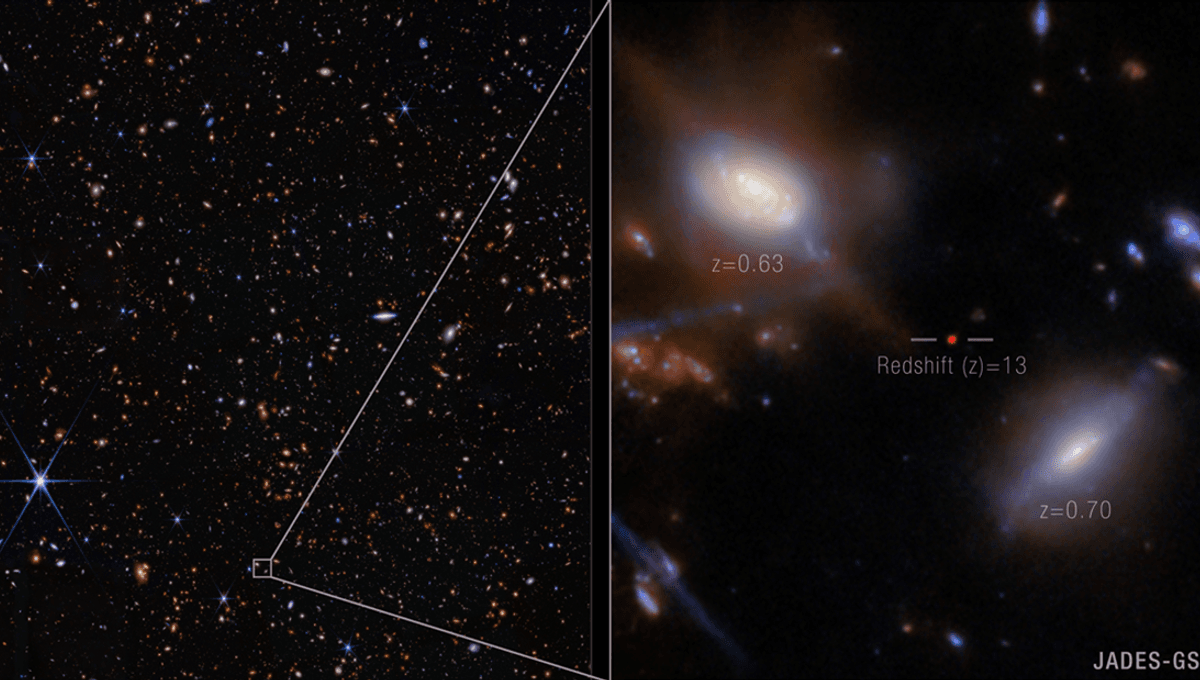
The great thing about having telescopes that can look further and further into the past is being surprised by what we see there.
ADVERTISEMENT
With the infrared JWST, we were hoping to learn more about the formation of galaxies, as well as clear up mysteries about how supermassive black holes became so large. But we have been thrown a few surprises as we look further back into the past.
One such mystery has been thrown up by the galaxy JADES-GS-z13-1, located around 33 billion light-years from us. This galaxy has a redshift of 13.0, which is a measure of how much a galaxy’s light has been stretched by the expansion of the universe. A redshift of 13 means that the light from the galaxy has been traveling to us from about 330 million years after the Big Bang.
There are older galaxies that we have observed, but this one turns out to be particularly weird. What makes it so strange are its spectra, which showed a large spike in Lyman-alpha, or the hydrogen emission line. While stars are made of hydrogen – so this might not seem too weird – this is an emission line we were not expecting to see this early in the universe.
“The early universe was bathed in a thick fog of neutral hydrogen,” Roberto Maiolino, a team member from the University of Cambridge and University College London, explained in a statement. “Most of this haze was lifted in a process called reionization, which was completed about one billion years after the big bang. GS-z13-1 is seen when the universe was only 330 million years old, yet it shows a surprisingly clear, telltale signature of Lyman-alpha emission that can only be seen once the surrounding fog has fully lifted. This result was totally unexpected by theories of early galaxy formation and has caught astronomers by surprise.”
Before reionization, when enough stars were formed to reionize hydrogen gas, cosmologists believed that there was a cosmic “dark age” when the universe was filled with a thick “fog” of neutral hydrogen, which gradually cleared as stars and galaxies formed. By redshift 6, around 12.716 billion years in our past, astronomers believe that this process would have been complete. But before then, ultraviolet light should be more and more difficult to see, as it would be obscured by more and more hydrogen stripped of its electrons.
And yet, here is JADES-GS-z13-1, defying our best models of the universe.
ADVERTISEMENT
“We really shouldn’t have found a galaxy like this, given our understanding of the way the universe has evolved,” Kevin Hainline, a team member from the University of Arizona, added. “We could think of the early universe as shrouded with a thick fog that would make it exceedingly difficult to find even powerful lighthouses peeking through, yet here we see the beam of light from this galaxy piercing the veil. This fascinating emission line has huge ramifications for how and when the universe reionized.”
“Seeing the line at REDSHIFT 13 is INSANE, everyone,” Hainline added on X when a preprint of the paper was first posted. “It’s so shocking that when we saw it in our JADES data it almost took the focus away from our confirmation of JADES-GS-z14-0, because it was so unprecedented. How is this light finding its way to us through the opaque universe?”
Unfortunately, we do not have an explanation of why this galaxy’s hydrogen emission line would be visible so early in the universe. Modified Newtonian Dynamics (MOND) predicts that reionization would take place earlier than the standard model suggests, but it is a little early to suggest new physics, with the team saying that an accreting supermassive black hole and associated ionization cone may offer an alternative explanation for the broad Lyman-alpha line, among other possibilities.
ADVERTISEMENT
“The large bubble of ionized hydrogen surrounding this galaxy might have been created by a peculiar population of stars — much more massive, hotter and more luminous than stars formed at later epochs, and possibly representative of the first generation of stars,” Joris Witstok of the University of Cambridge added.
For now, we will have to wait for further observations of the early universe for more clues to what is going on here.
The study is published in Nature.
Source Link: JADES-GS-z13-1: JWST Finds "Totally Unexpected" Galaxy From The Dawn Of The Universe